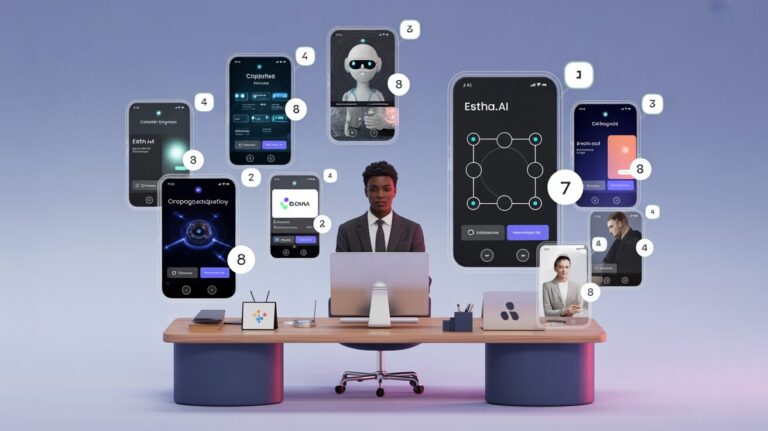Table Of Contents
- Introduction: The Rise of No-Code AI Personal Assistants
- What is an AI Personal Assistant Builder?
- Top AI Personal Assistant Builder Platforms
- Feature Comparison Chart
- How to Choose the Right AI Assistant Builder
- Popular Use Cases for Custom AI Assistants
- Future Trends in AI Assistant Development
- Conclusion
In today’s rapidly evolving digital landscape, AI personal assistants have transformed from novelty to necessity. What was once the exclusive domain of tech giants and coding experts has now become accessible to everyone, thanks to the emergence of no-code AI assistant builder platforms.
Whether you’re a content creator looking to engage your audience, a small business owner aiming to streamline customer service, or an educator seeking innovative teaching tools, the ability to create customized AI assistants without writing a single line of code represents a revolutionary shift in how we interact with technology.
This comprehensive guide compares the top AI personal assistant builder platforms available today, examining their features, usability, pricing, and ideal use cases. By the end, you’ll have a clear understanding of which platform aligns best with your specific needs, technical comfort level, and budget constraints.
No-Code AI Assistant Platforms Compared
Find your perfect solution without writing a single line of code
Top 5 AI Assistant Builder Platforms
1. Estha AI
Build custom AI apps in 5-10 minutes with drag-drop-link interface
2. Botpress
Visual conversation builder with hybrid approach for developers & non-developers
3. Voiceflow
Visual canvas for designing voice & chat interfaces with collaborative tools
Key Selection Factors
Technical Expertise
Choose platforms that match your current skills while enabling growth
Time Investment
Consider build time requirements vs. your deployment timeline
Use Case Complexity
Map conversation flows and knowledge requirements beforehand
Popular AI Assistant Use Cases
Customer Support
24/7 FAQ handling, issue troubleshooting & human escalation
Educational Tools
Study aids, quizzes, and personalized tutoring assistants
Lead Generation
Website engagement, contact collection & lead qualification
Content Creation
Idea generation, research assistance & content organization
Future AI Assistant Trends
Multimodal Interaction
Beyond text to visual and emotional recognition
Hyper-Personalization
Adaptive experiences based on user behavior
AI Marketplaces
Sharing and monetizing custom AI solutions
Ready to build your own custom AI assistant?
What is an AI Personal Assistant Builder?
An AI personal assistant builder is a platform that enables users to create, customize, and deploy artificial intelligence-powered virtual assistants without requiring programming knowledge. These platforms typically offer intuitive interfaces, pre-built templates, and drag-and-drop functionality that democratizes AI development.
The core components of most AI assistant builders include:
- Conversational design tools: Visual interfaces for creating dialogue flows and conversation paths
- Natural Language Processing (NLP) capabilities: The ability to understand and process human language
- Knowledge base integration: Methods to incorporate your specific information and expertise
- Deployment options: Ways to publish your assistant across websites, messaging platforms, or apps
- Analytics and improvement tools: Features to monitor performance and refine your assistant over time
The most significant advancement in this space has been the shift from code-heavy development to visual, intuitive interfaces that anyone can master. This democratization of AI technology means businesses of all sizes can now leverage powerful virtual assistants without the need for specialized technical teams.
Top AI Personal Assistant Builder Platforms
Let’s explore the leading platforms in the no-code AI assistant builder space, examining what makes each unique and best suited for different use cases.
1. Estha AI
Estha AI stands at the forefront of democratizing artificial intelligence with its revolutionary no-code approach. The platform’s standout feature is its intuitive drag-drop-link interface, which allows users to create fully functional AI applications in just 5-10 minutes without any prior technical knowledge.
What truly sets Estha apart is its holistic ecosystem approach. Beyond just building AI assistants, users gain access to:
- EsthaLEARN: Educational resources to master AI application development
- EsthaLAUNCH: Tools and support for scaling your AI solutions
- EsthaSHARE: Monetization and distribution capabilities to generate revenue from your creations
This comprehensive approach makes Estha ideal for professionals across diverse fields – from content creators and educators to healthcare professionals and small business owners – who want to create personalized AI solutions that genuinely reflect their expertise and brand voice.
The platform excels at helping users build various AI applications, including chatbots, expert advisors, interactive quizzes, and virtual assistants. A particularly valuable feature is the ability to embed these creations directly into existing websites or share them with communities, providing maximum flexibility for implementation.
Best for: Users with no technical background who want to quickly create sophisticated, customized AI applications that truly capture their unique knowledge and brand identity.
2. Botpress
Botpress offers a hybrid approach that caters to both non-technical users and developers. Its visual conversation builder allows for the creation of complex conversation flows through an intuitive interface, making it accessible to beginners while still providing the depth that more advanced users might need.
The platform shines with its extensive NLU (Natural Language Understanding) capabilities, allowing assistants to comprehend user intent effectively. Botpress also offers a significant degree of customization through its modular architecture, which allows for extensions and integrations.
While Botpress does offer a free open-source version, its more advanced features require paid plans. The learning curve is slightly steeper than some alternatives, especially when diving into more complex functionalities.
Best for: Organizations with mixed technical abilities who need a scalable chatbot solution that can grow in complexity over time.
3. Voiceflow
As the name suggests, Voiceflow initially focused on voice-based assistants but has expanded to support chat interfaces as well. Its visual canvas for designing conversations stands out for its clarity and intuitive nature, making it particularly appealing to designers and those with a visual thinking approach.
Voiceflow excels in prototyping and testing, allowing users to simulate conversations in real-time and refine their assistant’s responses accordingly. The platform also offers robust collaboration features, making it suitable for teams working together on assistant development.
While powerful, Voiceflow’s focus on conversation design means it sometimes requires integration with other platforms for deployment across all channels. Its pricing is also structured around team usage rather than individual features.
Best for: Teams focused on designing sophisticated conversation flows who value collaboration and thorough testing capabilities.
4. Writesonic’s Botsonic
Botsonic, developed by content platform Writesonic, takes a content-first approach to AI assistant creation. The platform excels at creating assistants that can leverage existing content, making it particularly valuable for knowledge base automation and content delivery.
What distinguishes Botsonic is its seamless integration with website content and documents. Users can quickly train their AI assistants on company websites, PDFs, and other text sources, creating knowledgeable virtual assistants with minimal setup. The platform also offers ready-to-use templates for common use cases like customer support and lead generation.
While Botsonic offers powerful content integration, it may not provide the same level of conversational flow customization as some other platforms. Its strength lies in quickly deploying assistants based on existing knowledge rather than building highly complex conversation architectures.
Best for: Content-heavy businesses looking to quickly transform their existing materials into interactive AI assistants with minimal setup time.
5. Amazon Lex
Amazon Lex represents the enterprise end of the no-code spectrum. Powered by the same technology behind Alexa, Lex offers sophisticated natural language understanding capabilities and deep integration with other AWS services. Though it provides visual interfaces for development, it still requires more technical understanding than pure no-code alternatives.
Lex’s strengths include its enterprise-grade security, scalability, and the ability to handle complex transactions. The platform also excels at multichannel deployment, allowing assistants to be published across websites, messaging platforms, and voice interfaces with consistent functionality.
The trade-off comes in accessibility and pricing. While Amazon has made efforts to simplify the Lex interface, it still presents a steeper learning curve than dedicated no-code platforms. Its pay-as-you-go pricing model can also be less predictable for those just starting out.
Best for: Enterprise users with some technical resources who need industrial-strength AI capabilities and integration with existing AWS infrastructure.
Feature Comparison Chart
| Platform | Ease of Use | Time to Build | Knowledge Integration | Customization | Deployment Options | Pricing Model |
|---|---|---|---|---|---|---|
| Estha AI | ★★★★★ | 5-10 minutes | ★★★★★ | ★★★★★ | Web, Embed, Standalone | Freemium with Beta access |
| Botpress | ★★★★☆ | 30-60 minutes | ★★★★☆ | ★★★★☆ | Web, Messaging platforms | Open-source + Paid plans |
| Voiceflow | ★★★★☆ | 1-2 hours | ★★★☆☆ | ★★★★★ | Voice, Chat (with integrations) | Team-based subscription |
| Botsonic | ★★★★★ | 15-30 minutes | ★★★★★ | ★★★☆☆ | Web, Embed | Bundled with Writesonic |
| Amazon Lex | ★★★☆☆ | 2-5 hours | ★★★★☆ | ★★★★★ | Multi-channel, AWS Integration | Pay-per-use |
How to Choose the Right AI Assistant Builder
Selecting the ideal platform for your AI assistant depends on several key factors. Consider the following when making your decision:
Technical Expertise
Be honest about your technical comfort level. Some platforms (like Estha AI) are specifically designed for non-technical users, while others assume some familiarity with concepts like data structures or API integrations. Choose a platform that matches your current skills while perhaps stretching them slightly for growth.
Time Investment
Consider how quickly you need to deploy your assistant. If speed is essential, platforms that offer templates and rapid deployment should be prioritized. If you have the luxury of time for a more custom solution, platforms with deeper customization capabilities might be worth the additional investment.
Complexity of Your Use Case
Simple informational assistants have different requirements than complex, transaction-based ones. Map out the conversations you expect your assistant to handle, paying particular attention to:
- The variety of topics covered
- The depth of knowledge required
- Whether you need integrations with other systems
- If personalization based on user data is necessary
Deployment Channels
Consider where your AI assistant will live. Do you need it on your website, in messaging apps, as a voice interface, or across multiple channels? Not all platforms support all deployment options equally well, so matching this to your audience’s preferred communication channels is essential.
Scalability and Growth
While your immediate needs might be modest, consider future growth. Look for platforms that can scale with your success, both in terms of conversation volume and complexity. Platforms with tiered pricing models often make this transition smoother.
Popular Use Cases for Custom AI Assistants
The versatility of no-code AI assistant builders has led to their adoption across numerous industries and applications. Here are some of the most effective implementations:
Customer Service and Support
AI assistants excel at handling frequently asked questions, troubleshooting common issues, and directing users to relevant resources. They can provide 24/7 support without increasing staffing costs and can be trained to recognize when human intervention is necessary.
Educational Tools and Tutoring
In educational settings, AI assistants can serve as study aids, quiz generators, and even personalized tutors. They can adapt to different learning styles and provide immediate feedback, making them valuable supplements to traditional education methods.
Lead Generation and Qualification
For marketing and sales teams, AI assistants can engage website visitors, collect contact information, and qualify leads based on predefined criteria. This ensures that human sales representatives focus their efforts on the most promising prospects.
Personal Productivity
Customized AI assistants can help individuals manage calendars, set reminders, organize information, and automate routine tasks. Unlike generic assistants, custom solutions can be tailored to specific workflows and preferences.
Content Creation and Curation
For content creators, AI assistants can help generate ideas, research topics, organize material, and even create first drafts. They can also help curate content for audiences based on preferences and engagement history.
The most successful implementations typically start with a focused use case and expand as users become more comfortable with the technology and its capabilities. Platforms like Estha AI that prioritize ease of use make it possible to iterate quickly, testing different approaches until finding the optimal solution.
Future Trends in AI Assistant Development
The field of AI assistant development is evolving rapidly, with several emerging trends that will shape the landscape in the coming years:
Multimodal Interactions
Future AI assistants will move beyond text and voice to incorporate visual elements, gestures, and even emotional recognition. No-code platforms will increasingly support these multimodal interactions, allowing creators to build richer, more nuanced experiences.
Hyper-Personalization
As AI models become more sophisticated, assistants will offer increasingly personalized experiences based on user behavior, preferences, and contextual understanding. This shift from generic responses to truly adaptive interactions will dramatically increase user engagement and satisfaction.
Specialized Domain Expertise
While general-purpose assistants will remain valuable, we’re seeing a trend toward highly specialized assistants with deep expertise in specific domains. No-code platforms that facilitate this specialization by making it easy to incorporate domain-specific knowledge will thrive.
AI Assistant Marketplaces
As creation becomes easier, expect to see the emergence of marketplaces where creators can share or sell their custom assistants. This democratization will accelerate innovation and make specialized AI assistants available to even more users.
For those looking to stay ahead of these trends, platforms that offer regular updates and new feature releases will provide the most value. Estha’s comprehensive ecosystem approach, with its focus on learning, building, and sharing, positions users well to adapt to these emerging trends.
Conclusion: The Democratization of AI Assistant Creation
The emergence of no-code AI personal assistant builders represents a fundamental shift in how we approach technology creation. What was once the exclusive domain of specialized developers has now become accessible to anyone with domain knowledge and a vision for how AI can enhance their work or life.
Each platform we’ve explored offers unique advantages depending on your specific needs. Estha AI stands out for its intuitive drag-drop-link interface and comprehensive ecosystem approach, making it particularly valuable for non-technical users looking to create sophisticated AI applications quickly. Botpress offers flexibility for growing technical needs, Voiceflow excels in conversation design, Botsonic simplifies knowledge integration, and Amazon Lex provides enterprise-grade capabilities.
The key to success lies not in finding the “best” platform in absolute terms, but rather in identifying the solution that best aligns with your specific requirements, technical comfort level, and long-term goals. By considering the factors we’ve discussed—from ease of use and time investment to scalability and deployment options—you can make an informed decision that sets you up for success.
As AI technology continues to evolve, these platforms will only become more powerful, offering even more capabilities to non-technical creators. The future belongs to those who embrace these tools, experiment boldly, and develop AI assistants that truly reflect their unique knowledge and perspective.
Ready to Create Your Custom AI Assistant?
Join the growing community of creators building powerful, personalized AI applications without writing a single line of code.



